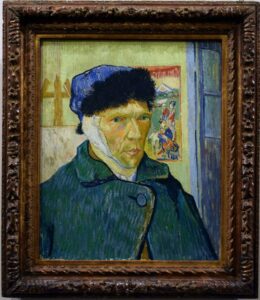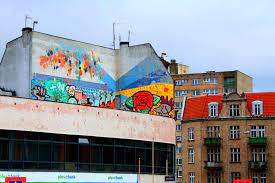Postmodernism in art is a complex, layered phenomenon that defies the conventions of traditional aesthetics.
It’s a rebellious mix of high and low culture, challenging our perceptions of what art can and should be.
We’ll jump into the eclectic and ironic world of postmodern art, exploring its origins, characteristics, and impact on contemporary culture.
Stay tuned as we unravel the enigmatic tapestry that is postmodernism in the art world, where nothing is quite as it seems.
Origins Of Postmodernism In Art
As art historians, we often look back to identifiable junctures in history – times where a clear shift in thinking and creative expression emerges.
For postmodernism, the roots are typically traced back to the mid-to-late 20th century, a period rife with cultural, social, and geopolitical changes that permeated artistic communities.
The disillusionment with modernist principles, especially the idea of objective truth and universal beauty, paved the way for a new, challenging perspective on art.
The transition from modernism to postmodernism didn’t happen overnight.
It evolved through a gradual process where artists sought to deconstruct established concepts and explore diversified narratives.
Key movements that signaled the onset of postmodernism include:
- Pop Art – with its embrace of popular culture and mass media,
- Conceptual Art – prioritizing idea over form,
- Minimalism – rejecting the
notion of personal expression in art.
These artistic endeavors, amongst others, laid the groundwork for what would later be understood as postmodern art.
They questioned the dominance and reverence of traditional artistic values and introduced a new layer of complexity.
In the realm of film and other visual narratives, postmodernism took shape through the use of intertextuality and pastiche.
Directors like Jean – Luc Godard and David Lynch moved away from linear storytelling and logical sequence, favoring non-linear narratives and abstract techniques.
Pulp Fiction, directed by Quentin Tarantino, exemplifies the postmodern collage of styles, blurring the lines between high and low culture.
Whilst pinpointing postmodernism’s exact genesis moment is challenging, it’s apparent that myriad intellectual inquiries and varied forms of cultural expressions contributed to its emergence.
Crucial philosophical texts, such as Jean-François Lyotard’s The Postmodern Condition, offered a theoretical backbone, reinforcing the shift in art practice.
These discourses invited a skepticism towards metanarratives and universalist claims, validating the postmodern artist’s quest for plurality and paradox.
Characteristics Of Postmodern Art
Postmodern art refuses to be pigeonholed into one specific style.
It’s a rich tapestry that includes a collection of traits, which can differ vastly from one work to another.
Understanding these characteristics helps to appreciate the nuance and depth of postmodern creativity.
Eclecticism and Diversity We see an embrace of diversity in postmodern art – a blend of styles, materials, and methods.

This eclectic mix serves as a direct response to the uniformity of modernist design.
Artists like Jeff Koons and Cindy Sherman explore this by combining high and low culture elements in their works.
- Challengers of Traditional Boundaries,
- Mix of Genres and Techniques,
- Embracing Paradoxes and Contradictions.
Irony, Parody, and Playfulness The postmodern approach often incorporates irony and parody as means of critiquing culture and society.
The use of satire can be seen in works like those from the pop art movement, including Andy Warhol, which comment on the pervasive nature of consumerism and mass media.

Deconstruction When we jump into the deconstructive aspect of postmodern art, we’re looking at the deliberate use of chaotic and disjointed patterns to undermine traditionally accepted concepts.
Artworks often leave more questions than answers, turning the audience into an active participant in the interpretation process.
Intertextuality Intertextuality is a hallmark of postmodern art, where one work can reference or incorporate elements from another.
In film, directors like Quentin Tarantino weave together different genres and styles to produce something entirely new yet familiar.

The result is a complex narrative that pays homage to various sources while establishing its own identity.
Pastiche Unlike parody, pastiche celebrates rather than mocks the works it references.
It incorporates various elements from prior styles and periods, creating a new vision that’s grounded in respect for art history.
Our experience with film allows us to see this in cinema that merges genres without necessarily critiquing them.
By appreciating these key characteristics, we gain a deeper understanding of the layered and intricate essence of postmodern art.
Whether we’re examining a sculpture, painting, or cinematic piece, the multifaceted nature of postmodernism presents us with endless possibilities for analysis and enjoyment.
Influences On Postmodern Art
Postmodernism in art didn’t emerge in a vacuum.
It’s the culmination of a variety of artistic, cultural, and intellectual movements of the 20th century.
To appreciate its eclectic nature, we’ll jump into the core influences that shaped this diverse art form.
The seeds were sown by movements like Dadaism and Surrealism that pushed against the status quo.
These movements showcased the absurdity of society’s norms and found beauty in the unconventional.
By the time postmodernism came into the picture, it was primed to break down barriers further and question everything we took as ‘given’ in art.
Cultural Movements That Shaped Postmodernism
The rise of consumer culture in the mid-20th century also played a pivotal role in the development of postmodern art:
- The influx of mass media – as television and advertising became dominant,
- The spread of pop culture – illustrated by the proliferation of comics, pop music, and cinema,
- Globalization effects – creating a melting pot of cultural influences.
These socio-cultural transformations led artists to experiment with satire, bricolage, and collage, techniques that became hallmarks of postmodern creativity.
Philosophical And Political Undercurrents
Philosophical theories, particularly those spearheaded by thinkers like Jacques Derrida and Michel Foucault, provided the intellectual scaffolding for postmodern art.
They put forward ideas like deconstruction and questioned the power structures within society, which deeply influenced artistic expressions.
Political turmoil, including the civil rights movement, feminism, and anti-war protests, stirred a sense of skepticism and rebellion.
Filmmakers, artists, and writers began using their medium to challenge political narratives and encourage audiences to think critically about the world around them.
It’s clear that postmodern art is an intricate tapestry, woven from a diverse array of threads.
These influences established a foundation for a movement that continues to question, blend, and redefine the boundaries of art.
Through this exploration, postmodernism becomes not just a style or concept but a way of seeing and understanding the ever-changing cultural landscape.
Postmodernism And High/low Culture
Postmodernism has blurred the lines between what’s traditionally considered high and low culture in art.
The movement disregards the hierarchy that privileges fine art over popular or mass culture, encouraging a more democratic approach to creativity.
In many cases, artists incorporate elements of both high and low culture, creating works that are accessible yet complex.
Take Julian Schnabel’s use of broken plates in his paintings, mingling a craft-like approach with high art sensibilities.
One notable aspect of postmodern art is its tendency to borrow from different media – – Films often incorporate visual arts techniques – Visual arts may include elements typical of cinema
By jumping over the barriers that once separated different forms of cultural expression, postmodern artists craft experiences that are multifaceted and rich with meaning.
For instance, Cindy Sherman’s film stills capture the essence of cinema through photographic means, playing with audience expectations and the conventions of both mediums.
We also see a rise in consumer culture’s influence within postmodernism.
References to advertising, television, and other commercial forms are prevalent, with artists like Andy Warhol and Roy Lichtenstein drawing directly from the visual language of consumerism.
This intersection between high and low culture opens a dialogue about value and prestige in art.
It questions the assumptions and biases that have long governed what is deemed worthy of attention and study, which fuels an ongoing reevaluation of our cultural landscape.
Impact Of Postmodernism On Contemporary Culture
Postmodernism has been a transformative force in contemporary culture, shaping not only the art world but virtually every facet of creative expression.
In cinema, postmodern techniques break the fourth wall and play with narrative structure in films like Pulp Fiction and Fight Club.
These films exemplify the postmodern tendency to refuse linear storytelling and instead, embrace fragmented, nonsequential narratives.
The influence extends beyond aesthetics, heavily informing the intellectual discourse of our era.
Contemporary culture thrives on the eclectic and the hybrid where notions of authenticity and originality are rigorously interrogated.
In embracing intertextuality, creatives make conscious references to other works, cultivating a rich dialogue between the past and present.
- Texts like The Simpsons and The Matrix draw from a plethora of cultural references,
- Art installations often juxtapose ancient history with modern-day issues,
- Fashion continuously revives and deconstructs styles from different eras.
Our social and political realms have also been impacted by postmodern thought.
The expansion of identity politics and the questioning of grand narratives can be tied back to postmodernism’s insistence on skepticism and the validity of multiple perspectives.
This has given rise to movements that challenge established norms and promote a more inclusive approach to cultural representation.
In the field of architecture, postmodernism has resulted in buildings that combine historical elements with contemporary design – a clear move away from the stark functionalism of modernism.
Take Frank Gehry’s Guggenheim Museum Bilbao, with its deconstructed silhouette and reflective materials, as an iconic example of postmodern architecture’s reach and innovation.
Digital marketing, too, is steeped in postmodernist sensibilities – branding strategies often incorporate self-referential humor and meta-commentary to engage with savvy consumers.
Campaigns display an acute awareness of the media-saturated environment in which they operate, leveraging pastiche and parody to connect with audiences on multiple levels.
also, the postmodern narrative in film has opened up new techniques in storytelling and visuals.

The pastiche style of filmmaking allows for a collage of genres, settings, and tones to coexist within a single narrative, forging a distinct path in the cinematic landscape.
What Is Postmodernism In Art – Wrap Up
We’ve traversed the dynamic and multifaceted landscape of postmodernism in art, uncovering its power to redefine norms and influence various cultural domains.
It’s clear that postmodernism isn’t just an artistic movement; it’s a lens through which we view and understand the complex layers of our contemporary world.
From the eclectic architecture that dots our skylines to the genre-bending films that captivate our imaginations, postmodernism continues to push the boundaries of creativity and expression.
As we move forward, we’ll undoubtedly see this movement’s principles shape future innovations, reminding us that art is a perpetual conversation between the past, present, and future.
Frequently Asked Questions
What Is Postmodernism In Art?
Postmodern art is characterized by an embrace of diversity, a challenge to traditional boundaries, and the mixing of genres and techniques.
It often includes paradoxes, contradictions, irony, parody, and playfulness to critique culture and society.
How Does Postmodern Art Use Chaos And Deconstruction?
Postmodern art often showcases chaotic and disjointed patterns as a form of deconstruction, undermining traditionally accepted concepts and highlighting subjectivity and fragmentation.
What Is Intertextuality And Pastiche In Postmodern Art?
Intertextuality refers to the way a work of art references or incorporates elements from another work.
Pastiche is a form of homage or mimicry that blends multiple genres or styles, creating a new narrative from various sources.
How Has Postmodernism Influenced Contemporary Culture?
Postmodernism has profoundly impacted contemporary culture.
Its influence is seen in cinema, intellectual discourse, social and political spheres, architecture, and digital marketing, affecting storytelling, building design, and branding strategies.
What Effects Does Postmodernism Have On Film Narratives And Visuals?
In cinema, postmodernism has led to the use of pastiche, which allows for a collage-like merging of different genres, settings, and tones within a single narrative, resulting in innovative storytelling and visuals.


